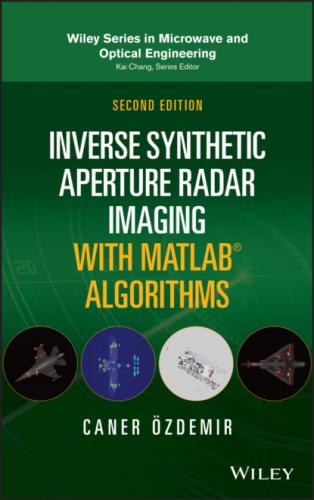Of course, time delay td is related to the range, R, of the target by the following equation:
where c is the speed of light in the air. Combining Eqs. 2.47 and 2.48, it is easy to determine the range of the target via
(2.49)
Figure 2.12 Operation of LFMCW radar: (a) time‐frequency display of the transmitted and received LFMCW signals, (b) the difference in the frequency between the transmitted and the received signals.
The block diagram of linear frequency‐modulated continuous wave (LFMCW) radar is shown in Figure 2.13. The LFMCW generator produces the LFM signal to be broadcasted by the transmitter. The receiver collects the returned wave that is multiplied with the transmitted signal. The output has both the sum and the difference of the transmitted and the received frequencies. As shown in Figure 2.12b, only the positive frequency difference, Δf is selected. Then the signal is fed to a discriminator that contains a differentiator plus an envelope detector. The output of the discriminator is proportional to the frequency difference, Δf. Once Δf is obtained, the range, R, of the target can be easily obtained via Eq. 2.50.
It is also obvious from Figure 2.12 that range ambiguity occurs when td > T. Therefore, the maximum difference in frequency can be Δfmax = KT, which means that the maximum unambiguous range can be determined as
Figure 2.13 LFMCW radar block diagram.
The above equation suggests that FMCW radar can only be used for short‐ or mid‐range detection of objects. Therefore, it is not suitable for long‐range detection.
2.6.3 Stepped‐Frequency Continuous Wave
Another popular radar waveform used to determine the range is the SFCW. This signal is formed by emitting a series of single‐frequency short continuous subwaves. In generating the SFCW signal, the frequencies between adjacent subwaves are increased by an incremental frequency of Δf as demonstrated in Figure 2.14. For one burst of SFCW signal, a total of N CW signals, each having a discrete frequency of fn = fo + (n − 1)·Δf, is sent. Each subwave has a time duration of τ and is of T distance away from the adjacent subwave. The total frequency bandwidth, B, and the frequency increment (or resolution), Δf, can be readily calculated as below:
(2.51)
(2.52)
The SFCW signal can be used to estimate the range of a possible target in the following manner. Suppose that the target is at the range distance of Ro from the radar. With a single measurement of monostatic SFCW radar, the phase of the backscattered wave is proportional to the range as given in the following equation:
Figure 2.14 SFCW signal in time‐frequency plane.
(2.53)
Here, Es is the scattered electric field, A is the scattered field amplitude, and k is the wavenumber vector corresponding to the frequency vector of f = [fo f1 f2⋯fN−1]. The number 2 in the phase corresponds to the two‐way propagation between radar‐ to‐ target and target to radar. It is obvious that there is FT relationship between (2k) and (R). Therefore, it is possible to resolve the range, Ro, by taking the inverse Fourier transform (IFT) of the output of the SFCW radar. The resulted signal is nothing but the range profile of the target. The range resolution is determined by the Fourier theory as
where BWk and BWf ≜ B are the bandwidths in wavenumber and frequency domains, respectively. The maximum range is then determined by multiplying the range resolution by the number of SFCW pulses:
Figure 2.15 Range profile of a point target is obtained with the help of SFCW radar processing.
We will demonstrate the operation of SFCW radar with an example. Let us consider a point target which is 50 m away from the radar. Suppose that the SFCW radar's frequencies change from 2 to 22 GHz with the frequency increments of 2 MHz. Using Eqs. 2.54 and 2.55, one can easily find the range resolution and the maximum range
